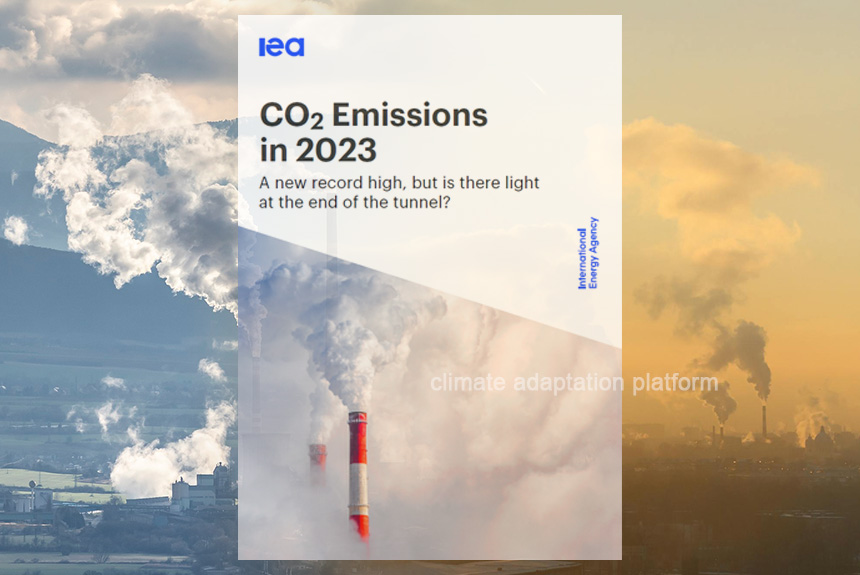A new analysis from the International Energy Agency shows that emissions in 2023 rose by around 1.1%, amounting to about 410 million tons (Mt) of carbon dioxide to reach a new record of 37.4 billion tonnes (Gt). Coal emissions accounted for 65% of the rise in CO2 in 2023.
Between 2019 and 2023, total energy-related emissions increased around 900 Mt. Without the growing deployment of five key clean energy technologies since 2019 – solar PV, wind, nuclear, heat pumps, and electric cars – the emissions growth would have been three times larger.
The rise of emissions in 2023 at 1.1% is lower compared to 2022’s 1.3% due to the growth of clean energies. In the last ten years before 2023, emissions grew slightly above 0.5% per year, the slowest since the Great Depression from the late 20s to the 30s.
Emissions in China rose by 5.2%, equivalent to around 565 Mt in 2023, which is by far the most significant increase globally caused by its economy reopening after the COVID-19 lockdowns. However, it also dominated the global addition of solar, wind power, and electric vehicle additions in 2023 at 60%.
Severe droughts have also led to a rise in emissions. Hydropower in China, the US, and other major economies could not operate at total capacity; hence, replacing them with fossil fuels accounted for the 40% emissions increase or 170 million tonnes of CO2 emitted.
Energy-related emissions in the United States fell by 4.1%, with the bulk of the reduction coming from the electricity sector. Last year, the European Union’s energy emissions fell by almost 9%, driven by a surge in renewable power generation and a slump in coal and gas power generation.
Clean energy growth is slowing down emissions
The report highlights that the rise in carbon emissions, at 1.1% in 2023, relative to global GDP growth at around 3% in 2023, is in keeping with the trend of slowing down carbon emissions observed in the last ten years ending with 2023, when emissions have grown slightly over 0.5% annually. Taking into a broader historical perspective, including the significant emission dips during the decades of World War 1 and the Great Depression, global CO2 emissions are showing structural decline even as prosperity grows.
The growth of clean energy is at the heart of this decline in emissions. The report notes that global capacity additions of wind and solar PV reached a record of almost 540 GW in 2023, up 75% from 2022. Global sales of electric cars climbed to around 14 million, an increase of 35% from 2022. Clean energy is having a significant impact on the trajectory of global CO2 emissions.
Read the report: CO2 Emissions in 2023
However, emissions must decline rapidly to hit Net Zero emissions by 2050.
The 2023 update of the IEA Net Zero Emissions 2050 report sets out a path to achieve this. The report noted that although the path to achieving the 1.5°C warming limit has narrowed, clean energy growth has kept the road open.
Actions in the 2023 Net Zero Roadmap include:
- Tripling the global renewable capacity by 2030 means adding 11,000 gigawatts of capacity.
- Fossil fuel emissions must fall by 97% by 2050; nearly 80% of fossil fuel demand in 2050 is for non-combustion applications or used with Carbon Capture Utilisation and Storage (CCUS).
- Improving energy efficiency, cutting methane emissions, and increasing electrification with technologies available today will deliver more than 80% of the emissions reductions needed by 2030 and is the main factor behind a decline of fossil fuel demand of over 25% this decade in the Net Zero Emissions Scenario.
- Cutting methane emissions from the energy sector by 75% by 2030 is one of the least cost opportunities to limit global warming in the near term.
- Increasing clean energy investments in developing countries. The world is set to invest a record US$1.8 trillion in clean energy in 2023, but to be on track with the net zero pathway, this investment must increase by US$4.5 trillion annually by 2030.
- Stringent and effective policies aligned with the net zero emissions scenario can spur clean energy deployment and cut fossil fuel demand by more than 25% by 2030 and 80% by 2050.
- By 2035, emissions need to decline by 80% in advanced economies and 60% in emerging and developing economies compared to the 2022 level. Current Nationally Determined Contributions are not in line with countries’ net zero emissions pledges, which are insufficient to put the world on a pathway to net zero emissions by 2050.
Source:
CO2 Emissions in 2023. A new record high, but is there light at the end of the tunnel? (2024 March). IEA50. Retrieved from https://www.iea.org/reports/co2-emissions-in-2023
Net Zero Roadmap: A Global Pathway to Keep the 1.5 °C Goal in Reach. 2023 Update. (2023 September 2023). IEA50. Retrieved from https://www.iea.org/reports/net-zero-roadmap-a-global-pathway-to-keep-the-15-0c-goal-in-reach



Leave a Reply